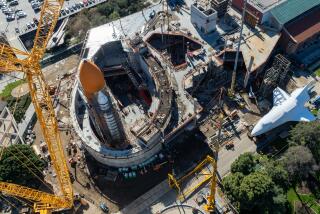New Space Shuttle Takes Shape in Orbiter Plant
- Share via
PALMDALE — While workers this week prepared the space shuttle Discovery for its scheduled piggy-back trip back to Florida on a jumbo-jet, Rockwell International employees were bonding tiles, bending metal and other assembly work on OV-105, the fifth space shuttle set for launch in February, 1992.
OV-105 has not received a name like the other shuttles. That name will be selected in a contest among the nation’s schoolchildren. “The name must have three syllables and have a nautical theme. There will be no Challenger 2,” said Bill Green, a Rockwell spokesman referring to the shuttle lost in the tragic January, 1986, accident.
At a briefing Tuesday on progress on OV-105 at the cavernous orbiter assembly plant here, Seymour Z. Rubenstein, president of space transportation systems for Rockwell, said, “So far we’re on schedule and right on budget.” Rollout is scheduled for April, 1991.
The National Aeronautics and Space Administration got a go-ahead from Congress in August, 1987, with a $1.3-billion appropriation for a shuttle to replace Challenger. Its total cost will actually be about $2 billion since it will use a completed $450-million spare structural system and an estimated $100 million for a new set of engines plus other preparation costs.
In addition, NASA is studying the possibility of attaching a drag chute that could be deployed to shorten the shuttle’s landing roll.
“Then we could land it anywhere from a primitive strip in Africa to Cape Canaveral,” Rubenstein said. The chute would have a 36-foot diameter and would be deployed from a trap door on the shuttle by a burst of pyrotechnics. “It would cost in the neighborhood of a couple million (dollars),” he said.
NASA is also considering a system that would enable a shuttle to remain in orbit for at least 16 days, doubling the current 8-day in-orbit capability. NASA said it would have the effect of tripling the time available for scientific experiments and lower risks, costs and vehicle wear.
Rockwell would modify at least one shuttle for the extra stay. “We would carry gaseous oxygen and hydrogen to produce more electricity, take more nitrogen as well as change the revitalization system” to produce air for longer periods, Rubenstein said.
The wings are now being mated to the mid-fuselage, which has already been coupled with the lower fuselage. Workers are busy cutting, gluing and fitting the 27,432 thermal tiles and weaving yards of heat resistant composite blankets.
All of these will form the shuttle’s thermal protective system that protects its thin skin against the furnace-like heat of reentry, varying from 1,800 to 2,600 degrees Fahrenheit.
More to Read
Sign up for Essential California
The most important California stories and recommendations in your inbox every morning.
You may occasionally receive promotional content from the Los Angeles Times.













